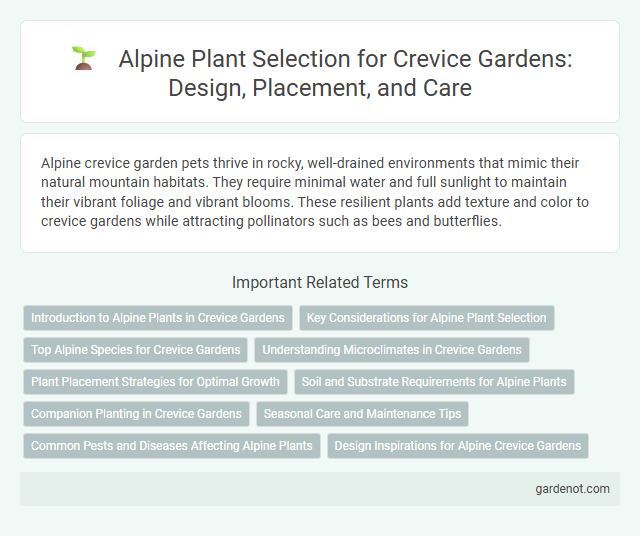Alpine crevice garden pets thrive in rocky, well-drained environments that mimic their natural mountain habitats. They require minimal water and full sunlight to maintain their vibrant foliage and vibrant blooms. These resilient plants add texture and color to crevice gardens while attracting pollinators such as bees and butterflies.
Introduction to Alpine Plants in Crevice Gardens
Alpine plants thrive in crevice gardens by mimicking their natural high-altitude environments with well-drained, rocky soil and minimal nutrients. Species such as Saxifraga, Sedum, and Lewisia are ideal for these gardens due to their compact growth and tolerance for harsh conditions. Their ability to anchor roots in narrow fissures makes crevice gardens a perfect setting for showcasing diverse alpine flora.
Key Considerations for Alpine Plant Selection
Alpine plant selection for crevice gardens requires careful attention to altitude adaptability, drought tolerance, and soil drainage preferences, as these plants thrive in environments mimicking mountainous rocky habitats. Emphasizing species with compact growth, such as Saxifraga, Edelweiss, and Dianthus, ensures resilience and visual harmony within narrow crevices. Prioritizing native alpine species promotes ecological balance while enhancing the garden's authenticity and long-term survival.
Top Alpine Species for Crevice Gardens
Top alpine species ideal for crevice gardens include Saxifraga oppositifolia, Androsace helvetica, and Silene acaulis, known for their compact growth and tolerance to rocky, well-drained environments. These plants thrive in the thin soils and cold, harsh conditions typical of alpine zones, making them perfect for crevice garden designs. Their vibrant blooms and textured foliage enhance the aesthetic appeal while promoting biodiversity in miniature rock habitats.
Understanding Microclimates in Crevice Gardens
Alpine plants thrive in crevice gardens due to the unique microclimates created by narrow rock gaps that provide excellent drainage and temperature variation. These microclimates mimic harsh mountain environments, allowing plants to endure extreme conditions such as intense sunlight and cold nights. Understanding these subtle environmental differences helps gardeners select and position alpine species to optimize growth and resilience.
Plant Placement Strategies for Optimal Growth
Alpine plants in crevice gardens thrive when placed in well-drained, narrow gaps that mimic their native rocky habitats, ensuring their roots avoid waterlogged conditions. Positioning sun-loving species on south-facing crevices maximizes sunlight exposure, while shade-tolerant varieties benefit from north-facing or shaded gaps. Incorporating varying depths and orientations in rock placements creates microclimates, supporting diverse alpine plant growth and resilience.
Soil and Substrate Requirements for Alpine Plants
Alpine plants thrive in well-drained, gritty soil with low nutrient content, mimicking their natural rocky mountain habitats. A substrate blend comprising coarse sand, gravel, and organic compost ensures optimal aeration and moisture retention while preventing waterlogging. Maintaining slightly acidic to neutral pH levels between 6.0 and 7.0 supports nutrient uptake vital for healthy alpine growth in crevice garden environments.
Companion Planting in Crevice Gardens
Alpine plants thrive in crevice gardens due to their preference for well-drained, rocky habitats that mimic their natural mountain environments. Companion planting of low-growing sedums, saxifrages, and cushion plants enhances moisture retention and provides microhabitats that protect alpine species from harsh winds and temperature fluctuations. Strategic pairing of drought-tolerant alpines with moisture-loving companions ensures balanced soil hydration and nutrient exchange, optimizing plant health and garden resilience.
Seasonal Care and Maintenance Tips
Alpine plants in crevice gardens require well-drained soil and minimal watering to mimic their natural mountainous habitat. Seasonal care involves removing dead foliage in spring to encourage fresh growth and protecting roots with mulch during winter frost. Regularly inspecting for pests and ensuring proper sunlight exposure maintains plant health and vibrant blooms throughout the year.
Common Pests and Diseases Affecting Alpine Plants
Alpine plants in crevice gardens are commonly affected by pests such as aphids, spider mites, and caterpillars, which can cause significant foliage damage and stunted growth. Fungal diseases like powdery mildew and root rot are prevalent in poorly drained crevice conditions, leading to weakened plant health and reduced flowering. Effective pest management and ensuring well-drained, rocky substrates are essential for maintaining vibrant alpine plant life in these specialized garden settings.
Design Inspirations for Alpine Crevice Gardens
Alpine crevice gardens draw inspiration from high-altitude mountain landscapes, replicating the natural fissures and rocky outcrops found in alpine environments. Design emphasizes narrow, deep rock seams to mimic natural water flow and root protection, promoting the growth of specialized alpine plants such as saxifrages, sedums, and dwarf conifers. Strategic placement of stones with varying textures and colors enhances microclimates, ensuring optimal drainage and sunlight exposure critical for alpine species' survival.
Alpine Infographic

 gardenot.com
gardenot.com